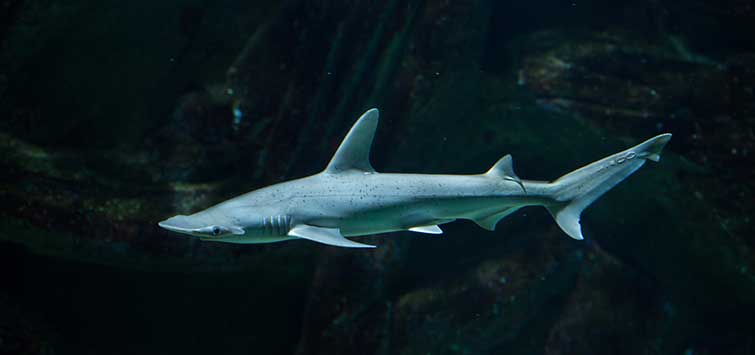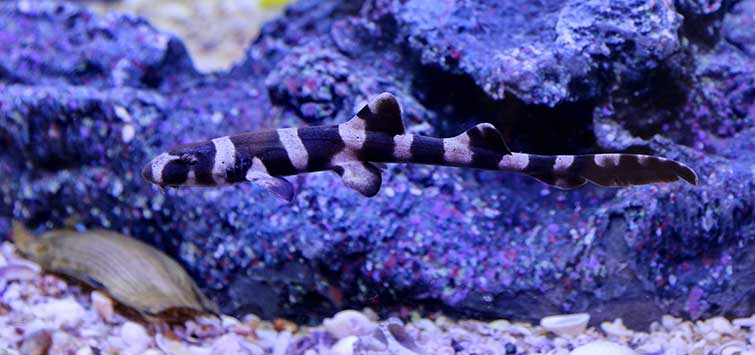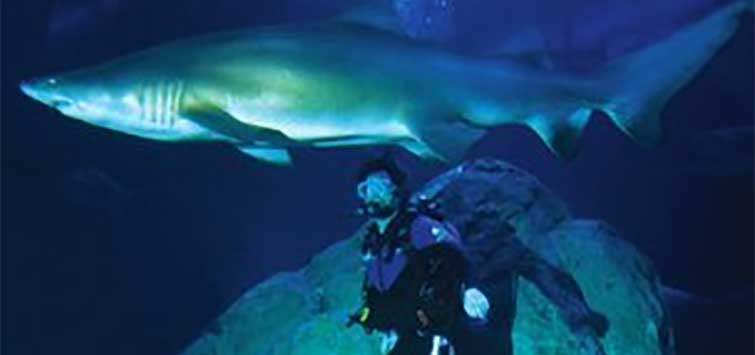Top of the Food Chain: The Bonnethead Shark Sphyrna tiburo: Is it Suitable for Home Aquariums?
Author: Brian M. Scott
For many marine hobbyists, the pinnacle of the aquarium hobby is the successful keeping of a shark. While maintaining any species of marine shark in an aquarium is a noble feat, it’s not one for everyone to attempt, and not for just any species of shark, either.
The purpose of this article is to bring some interesting facts to light about the bonnethead shark Sphyrna tiburo, therefore allowing those interested in keeping sharks to decide if this species is the right one for them to try. Before we dive into the suitability of this species, let’s first have a very brief look at some specific areas of interest regarding this species.
Natural History
The bonnethead Sphyrna tiburo (Linnaeus 1758) is a member of the family Sphyrnidae, the hammerhead, bonnethead, or scoophead sharks. Bonnetheads are found in shallow waters in the Western Atlantic from North Carolina south to southern Brazil, including most of the Caribbean and Gulf of Mexico. They are rare in Bermuda. In the eastern Pacific, they occur from southern California south to Ecuador. Bonnetheads are at home in a wide range of habitats. Always occurring in small groups, numbering from just a few specimens to perhaps a dozen or so, the bonnethead can be found over inshore coral reefs, estuaries, and shallow bays over sand and mud bottoms.
Water Preferences
Sphyrna tiburo is a subtropical shark that prefers water in the low to mid 70s Fahrenheit. While generally considered a strictly marine species, they will readily travel in and out of brackish estuaries with the ebbing and flooding of tides. Bonnetheads need water that is well oxygenated and of generally good quality. Few problems will occur if extremes in water chemistry are avoided.
Hunting
Of the group, only the bonnethead has a head that is semicircular-shaped in front. Other hammerheads are generally flat or scalloped. The broadened front end of the bonnethead acts as a sort of critter detector, which allows them to hone in on edible foodstuffs lying just under the surface of the bottom. Chiefly crustacean feeders, bonnetheads prefer crabs, shrimps, small lobsters, and various shellfish over most other foods. Of course, being sharks they certainly enjoy a meal of fish whenever the opportunity presents itself, but they generally are not nimble enough to give chase over extended ranges in search of bait fishes and such.
General Biology
Bonnethead sharks are viviparous, meaning they give birth to live young, or pups. Females give birth to between six and nine pups per litter, which measure somewhere around 35 cm (15 inches) or so at birth. Young bonnetheads grow fast their first year and eventually reach about 150 cm (5 feet).
Generally peaceful, territorial disputes between males are usually observed during the breeding season only. Females and immature specimens are very passive with each other. Ironically, many hobbyists who are self-proclaimed shark “experts” claim the bonnethead is a great community shark. I strongly disagree (see below). There is a strong degree of sexual segregation that occurs with the bonnethead, as well as with other hammerheads. Females will often travel with schools of other females, and males show the same behavior.
Aquarium Suitability
Deciding if a species is suitable for a home aquarium requires potential keepers to be brutally honest with themselves. When dealing with high-end marine species, which are almost always wild collected, a different type of thinking needs to be applied—thinking outside the glass box, if you will.
You need to realize that, in this case, you are contemplating the keeping of an actual free-roaming (requiem) shark species—one that quite literally has the freedom of thousands of miles of open inshore ocean to patrol when left in the wild. Don’t get me wrong, I love seeing sharks in aquariums just as much as the next guy, but sometimes we need to be realistic in our efforts and control our desires. What follows is a brief list of topics that are important for hobbyists contemplating the keeping of this species.
Aquarium Size
Unlike many other species covered in this monthly column, a 1000-gallon aquarium is not a solution to being able to keep bonnetheads. Their eventual size and swimming habits are just not suited to a glass box. At over 5 feet in total length (TL) as adults, these ocean predators demand seriously spacious quarters. Even a “standard” 144- x 48- x 48-inch tank is too small for these requiem sharks!
Aquarium Shape
Okay, so a 1000-gallon tank won’t do it, huh? What about a 2000-gallon tank? Well, maybe, as long as it’s not a square or rectangle. Requiem sharks swim a lot—not necessarily all the time, but a lot for sure, and these sharks tend to find the corners of rectangular or square aquariums especially annoying.
Sharks generally don’t go in reverse, and when a bonnethead gets “caught” in a corner it tends to thrash back and forth. The thrashing gets more and more violent as panic ensues—because they feel trapped. Eventually their sensitive, broadened heads get chafed up, and infection can set in. At that point it may be too late to save them. Sharks, like all elasmobranchs, are notoriously difficult to medicate successfully once ill.
Oval or round tanks, or at least tanks with rounded corners, are needed so the bonnetheads don’t get caught in the sharp angle of the 90-degree corner found on most standard types of aquariums; a rounded aquarium of 12 to 15 feet in diameter would be the minimum for one of these sharks.
Decor
Sharks generally do not need decorations in their aquariums, nor should they particularly have too many of them. Only on a few occasions have I seen shark setups that were decked out with fancy, realistic decor.
Sharks not only have very sensitive front ends, but they have equally sensitive skin, which may be easily scratched on objects that may not even seem sharp to our touch. This is somewhat ironic, being that shark skin can actually chafe human skin very badly when it’s rubbed in the wrong direction. Regardless of whether you are thinking about keeping a bonnethead or any other type of shark, use caution and be very selective when choosing decorations for the tank.
Aggression
While bonnetheads are not particularly aggressive in, say, a great white shark sort of way, they are still sharks and they have sharp teeth, which are capable of inflicting serious wounds to human skin and flesh. There is one documented account of an attack by a bonnethead on a human. For a 5-foot shark, they sure do pack a lot of punch.
Aggression towards other tank inhabitants is probably more a concern, however. And aggression received from other tank inhabitants is yet another thing to be worried about. In most cases, people who keep bonnetheads house them alone, and this is the only way that I would support their keeping, except for maybe in oceanariums where many species are housed together (and to be truthful, oceanariums are the only place in captivity that I feel these animals belong).
I have seen some amazing setups where a single bonnethead makes a wonderful showpiece. Of the half-dozen or so folks that I have spoken to who keep or have kept this species, most agree that if you start out with a few specimens you will end up with only one in most cases. I mentioned earlier that bonnetheads are rather peaceful, but that was in reference to their behavior in the wild. In aquariums, for some reason, bonnetheads do in fact show some territorial tendencies that only intensify as the time kept in close quarters increases.
Water Quality
The water quality for any aquarium containing sharks must be superior; anything less is simply a waste of your time, money, and effort, and will end up killing the shark. There is no gray area here. If you do not have the experience in maintaining nearly perfect water quality all the time, and don’t know how to even achieve nearly perfect water quality from the start, then sharks are not for you—not yet anyway.
In nature, bonnetheads avoid extremes or they simply move out of them when water of poor quality is encountered. In aquariums they don’t have a choice. Poor water leads to stress, which leads to disease and quickly to death. If you are not 100 percent sure of your abilities as a marine hobbyist, then don’t try yet. Wait and get your fins wet a little more with fishes that are hardier and preferably captive bred.
Stressors
Sharks in general are easily stressed creatures. There is quite a lot to cover—too much, in fact, for this article—regarding what specifically stresses them. In most cases just the fact that these majestic creatures are being stripped from the sea and stuffed in a comparatively small glass box is stress enough to basically shorten their lives by an estimated 75 percent. Those that do thrive are few and far between but certainly do prove a true testament to the abilities of the keeper.
Conclusion
Bonnethead sharks are amazing creatures that deserve the very best setup and care that can be offered to them in captivity. It is impossible to emphasize enough just how important experience and quality control is in maintaining these animals in home aquariums. In most cases (basically all cases), these animals are best left to the trained experts of public aquariums who have the resources available to them to house and care for them. Even though bonnetheads attain a relatively small size in comparison to other requiem sharks, they still need far more swimming room than you may think. Perhaps a few visits a year to a local aquarium that houses bonnetheads will be enough to satisfy the craving to keep these majestic sharks yourself.
See the full article on TFH Digital http://www.tfhdigital.com/tfh/200709/#pg58

.png?h=595&iar=0&w=2781&hash=5FD5E69473BCC22199FBFA2FB71B6033)



